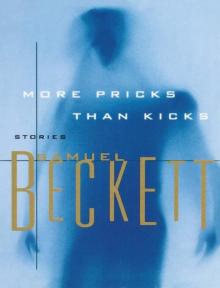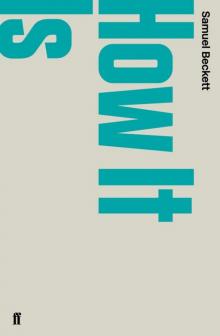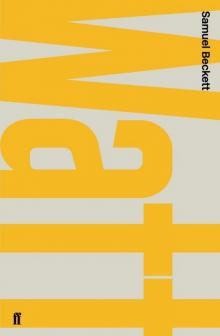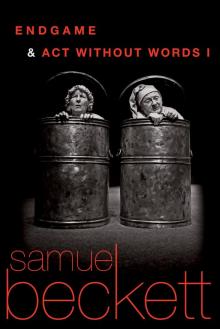- Home
- Samuel Beckett
Murphy
Murphy Read online
SAMUEL BECKETT
Murphy
Edited by J. C. C. Mays
Contents
Title Page
Preface
Table of Dates
Manuscript notes towards Murphy
Murphy
1
2
3
4
5
6
7
8
9
10
11
12
13
About the Author
About the Editor
Titles in the Samuel Beckett series
Copyright
Preface
I
Murphy is the first extended piece of writing that Beckett was satisfied with, and it is easy to see why. What he wrote before, in both verse and prose, had been dazzling, clever and inventive, and yet the same qualities evidently derived as much from an instinct to withhold as from the desire to share – talent gets paraded in front of what cannot bear examination. The accomplishment represented by Murphy therefore marks a turning point. It gave its author sufficient self-belief to sustain him through tedious negotiations with a succession of publishers, during which he refused to revise what he had written. It made it reasonable for him to set about translating the English publication into French himself as his next task, and later, following Godot, its publication in America prepared the way for a broader understanding of his writing throughout the English-speaking world. Murphy is the book in which Beckett discovered his first, most pressing theme or, more accurately, the beginning of a way to manage a situation in which he found himself immured. The protagonist is the first of a series whose names begin with the thirteenth letter of the alphabet, on whom Beckett’s writing afterwards came to turn. Conflicted ambitions complicate his earlier writing, and the same frustration is not completely under control in Murphy, but what bitterness survives is balanced by another, sweeter quality, a ‘compassion’ that Thomas MacGreevy and Brian Coffey intuited from the first, and that survived to spread a benign influence across the writing of his later years.
Murphy was written by hand in six notebooks across the space of ten months, and the pace of Beckett’s progress is charted by references in letters to MacGreevy and other friends. He had returned to London from Dublin in September 1934 and had been in lodgings in Gertrude Street in West Brompton almost a year before he sat down to write. He began in mid-August 1935 and wrote some 9,000 words during the following four weeks, at which point he revealed that he had already decided the kite-flying episode in Hyde Park would conclude the book. Pressing on, he completed 20,000 words by October and had only three chapters to go by February 1936. The collection of poems, Echo’s Bones, was published in November 1935, and he returned home to Foxrock in December. Work on the novel was halted for a couple of months but revived with springtime in the garret of Clare Street, Dublin, where he had earlier written More Pricks Than Kicks, and he was able to bring it to a close by early June 1936, dispatching a typescript to Chatto and Windus, the publishers of both Proust and More Pricks Than Kicks, before the end of the same month.
The more or less steady advance in the process of composition suggests a sense of purpose in the writing of Murphy that is confirmed by surrounding preparations and circumstances. The book draws on Beckett’s experience of living in London, and on material he noted in his reading or drafted previously. However, he read for the new task with deliberate intent – in Elizabethan and Jacobean drama, Fielding, Spinoza and Geulincx – in a way that reinforced, rather than confused, his design. Thus, a rejected short story entitled Lightning Calculation (now at Reading University Library), centring on a protagonist called Quigley, provides a character who makes a fleeting appearance (p. 13) and contributes material incorporated in the Lyons tea shop episode. The Whoroscope notebook (also at Reading) contains notes and synopses of material concerning horoscopes and the duties of male nurses at Bedlam, among other things, which were entered before, during and quite late in the process of composition. Beckett underwent therapy before and during the period when he was writing, and his reading in Gestalt and Külpe psychology finds a place, but the visits to his friend Geoffrey Thompson at Bethlem Royal Hospital in Kent between February and October 1935 were deliberate field trips undertaken to gather material. Although he was still writing under the shadow of Joyce’s working methods, the nexus of allusion here is held in place by a firmer sense of purpose than ever before. The book was written out of a sense of a dilemma understood as both personal and shared: the half-allowed pretension to mastery is simultaneously a joke and, seriously, an image of this crucial dilemma.
The instinct that led Beckett from one method of writing to another, as he moved on from prentice work to discover his own subject and style, was confirmed by the revisions he made between the time he first submitted his book for publication and when it was published two years later. Murphy was turned down by Chatto on 15 July 1936, then by Heinemann on 4 August, soon after which he gave a copy to George Reavey to circulate among English publishers, as he had given another copy to Mary Manning Howe to do the same in the US. At the end of September 1936 he left for Germany, and did not return until the beginning of April 1937. A succession of rejections by publishers on both sides of the Atlantic followed during his absence, some indicating that they might be interested if changes to make the book more saleable were allowed, which Beckett in his turn refused summarily to do. Eventually, following dismal months at Foxrock during which he had a car accident, failed to make progress with a play centred on Dr Johnson, left again for Paris (October) and returned briefly to Dublin to take part in a bruising libel action on behalf of his uncle, he learned at long last – back in Paris, on 9 December 1937 – that Murphy had been accepted for publication by Routledge. Jack Yeats recommended it to his own editor there, T. Murray Ragg, and the usual literary reader Herbert Read afterwards confirmed Ragg’s acceptance with enthusiasm. As it happens, Beckett was stabbed in the street in the early hours of 7 January 1938, and received page proofs while he was recovering from stab wounds in hospital. He made alterations and insertions, and the book went into production in February. Materials for 1,500 copies were printed and copies went on sale on 7 March, price 7/6d. Beckett was surprised and cheered by the turn events had taken and only disappointed that the cover failed to include a photograph of two chimps playing chess that had caught his eye in the Daily Sketch at the time he finished writing.
Beckett’s preparations and the composition of his text were particularly orderly; similarly Routledge’s production was notably efficient, but the relation between the two sets of events contains complications that are significant. First, while the text of Murphy draws on the unpublished story Lightning Calculation and the Whoroscope notebook, these materials are prior to and/or supplementary to the process of composition, not constitutive. Story and notebook are used in different ways, to be sure, but they both fall into the category of what German editors call paralipomena. The letters and private memoranda to which reference has also been made are similarly adjacent. Second, the manuscript in which Beckett wrote out his novel continuously in six small exercise books, is in private hands and not available for consultation. Beckett gave it to his friend Brian Coffey, who in turn sold it on during the 1960s, and the brief accounts we have of it – for instance, by Beckett’s biographer, James Knowlson – are insufficient to gauge its relationship to the extant typescript. One can only guess that the sixth exercise book, which has a different-coloured cover, might contain the closing chapters of the work completed after the bout of writer’s block in Ireland.
Finally, the corrected carbon at the Humanities Research Center at Austin, Texas, bound in cloth-backed wrappers and signed and dated by its author at 6 Clare
Street, 26 June 1936, must be treated with caution. Beckett mentioned to Reavey a year later that there were three manuscripts (he presumably meant typescript copies): the HRC carbon, which is numbered III, presumably remained in his possession during the time that the other two circulated independently as directed by Reavey and Manning. The HRC carbon is also, presumably, the copy known to have been lent at different times to MacGreevy, Coffey and Denis Devlin to read before publication. This, together with the fact that it includes a correction not taken forward into the Routledge printing, suggests that it was not the typescript used for setting the printed copy. Indeed, the two pairs of verse lines that appear on page 235 of the Routledge text are not present in the HRC typescript, yet they are ticked in the Whoroscope notebook (they derive from songs by Robert Greene and George Peele, respectively), which confirms the sophisticated position occupied by HRC in the line of descent. Other instances where the Routledge text diverges from the HRC typescript are the insertion of ‘the Pergamene Barlach’ into Routledge page 239, and the contraction of a previously more elaborate description of ‘the ravaged face’ on page 282. The only conclusion must be that Beckett supplied copy in another typescript, now lost, and it is on record that he made changes on proofs that are now also lost. The consequence is that while it is clear how the book came together, there are gaps in the story of its production that leave room for disagreement over the details of the text Beckett intended. I return to this matter below.
II
Reviews of the Routledge Murphy appeared within weeks of publication and were mixed. Kate O’Brien’s in The Spectator pleased Beckett most, and Dylan Thomas’s in the New English Weekly was perceptive. O’Brien communicated her enjoyment and made it her book of the week, praising its ‘gladdening, quickening’ spirit. She admitted that there was much she failed to understand but insisted that this did not matter: ‘Rarely, indeed have I been so entertained by a book, so tempted to superlatives and perhaps hyperboles of praise.’ Thomas differed from others who balanced praise with blame. He straightforwardly called the book ‘wrong’, but in explaining how its qualities are at variance demonstrated that he took Beckett’s literary methods seriously. The following year, the only review to appear in Ireland – by Austin Clarke, anonymously in the Dublin Magazine – damned it with circumspection, while Beckett’s position among his younger contemporaries was sketched for French readers with greater understanding by Anatole Rivoallan in his survey Littérature Irlandaise contemporaine. The most searching response, by Brian Coffey, did not find a publisher and may therefore be said to be the best review the book never had. (It may now be found, with a surrounding commentary, in The Recorder: A Journal of the American Irish Historical Society 18:1–2 (Fall 2005), 95–114.) Coffey presented the confrontation between Murphy and Mr Endon, as seen by the author – the qualification being all-important – as the heart of the matter, and Beckett’s appreciation can be gauged by his subsequent gift of the manuscript to Coffey. How widely the book circulated and was absorbed into the literary tradition is another matter: it appeared at the end of a decade when a decade of literary experiment was overtaken by a world war.
Routledge appear not to have anticipated immediately large sales. Three different bindings that now command high prices for the first edition among collectors suggest that copies were made available as need arose, copies in the third binding being sold at a reduced price of 4/- . The publisher’s records show that about 568 copies sold in 1938, 23 in 1939, 20 in 1940 and 7 in 1941, and the book was allowed to go out of print in March 1943. Only half the 1,500 copies printed were bound up and circulated, and the 750 unbound sheets were sold on. What happened to them is unknown: they might have been destroyed in an air raid or simply shredded. Beckett’s profits amounted to £20 minus income tax. If he had written no more, his book would have fallen into place in the wake of Joyce, alongside Flann O’Brien’s At Swim-Two-Birds (1939) – another ‘experimental’ novel issued by a prudent London publisher in successive, different bindings – and Raymond Queneau’s On est toujours trop bon avec les femmes (1947). Ten and more years on, the book continued to attract discriminating admirers – Iris Murdoch, Vivian Mercier, Aidan Higgins – but they were a small and scattered band.
Meanwhile, barely a month after the Routledge publication, Beckett began translating his novel into French. His reasons were mixed: partly, one supposes, he understood the value of what he had written, to himself if not immediately to the reading public; partly because, while his future appeared to lie in Paris, a crossroads in his evolving career left him feeling at a loose end. He enlisted the help of his old friend Alfred Péron, lecteur at Trinity College Dublin in 1926–28, who was now teaching at the Lycée Buffon: they translated nine chapters by December 1939 and finished the whole by February 1940. Beckett continued to revise the translation in a desultory way during 1940, and following the end of the war, in October 1945, Bordas issued a contract for a French Murphy and all future work in French and English. The French Murphy was published on 15 April 1947, dedicated to Péron, who had died in a concentration camp in 1945, as number five in a series supposedly ‘marqué par un caractère de recherche et d’aventure spirituelle’. The venture was oddly conceived and the publishers made no effort to have Beckett’s contribution reviewed. Reports of the number of copies sold vary, but it was certainly small: perhaps as few as the Routledge edition, without the burst of sales during the first year. According to the Bordas records, only 735 copies of the 3,500 printed had been sold after four years, which reduces to 285 copies because 350 were defective and 100 were given away free. A dispute arose, Bordas asked Beckett to repay what he had been advanced and, after negotiations extending from May 1951 to December 1953, Bordas agreed to Jerôme Lindon’s purchase of the remaining 2,750 copies in their possession. Lindon, who had already published the three novels of Beckett’s French trilogy and En attendant Godot under the Éditions de Minuit imprint, issued the Bordas sheets of Murphy in new covers in 1954. A second Minuit edition was called for in 1956, a third in 1965 and so on: the novel was quickly assimilated into Beckett’s French oeuvre.
One other translation in which Beckett was involved must be mentioned because, besides all else, it has some bearing on the present edition: this is the German translation published by Rowohlt in June 1959. The translator is named on the title page as Elmar Tophoven, who had been lektor in German and a doctoral student at the Sorbonne since 1949 (he was afterwards successor to Paul Celan at the École Normale). He translated Godot into German on his own initiative while he was a student and quickly became Beckett’s preferred translator from French: Warten auf Godot was published in 1953, Malone stirbt in 1958, and Endspiel and Der Namenlose both in 1959. However, while he translated from French into German in Gedichte (1959), the translation of English poems in that volume was undertaken by Eva Hesse; and his translations of English play titles undertaken at the time (Alle, die da fallen in 1957 and Das letze Band in 1959) were undertaken in collaboration with Ericka Schöningh (whom he was to marry). The fact that the German translation of Murphy was published when it was, in 1959, under his name only, strongly suggests that he had considerable assistance from Beckett, and this is confirmed from other sources who knew him well. The point is not the translation itself, which, like the Bordas-Minuit version, makes cuts and changes such as the difference between English and the other language demands. Allusions have to be modified if they are to retain their point; humour is a quality that reaches deep into conventional responses and shifts subtly in the process of cultural exchange. The point is that Beckett was once again deeply involved in thinking through his English text, and the particular situation almost certainly prompted both him and Tophoven to refer to solutions arrived at in the previously translated French version. Both the French and the German translations provided opportunities to correct material errors in the English text, some of which were taken and others ignored. In this respect, they contribute as much to an improved text as the several editio
ns in English that followed the Routledge text of 1938.
The first reprinting of the English Murphy was a photographic reissue, by Grove Press, New York. It was published on 16 May 1957, price $3.50 cloth and $1.95 paper. A trial version of the cover by Francine Felsenhal was quickly superseded by one by Roy Kuhlman; and there was also a differently bound limited signed edition. It followed on Grove Press editions of Beckett’s own translations of his French writing published by Minuit, in a similar format, and it has been reprinted many times. The impact on readers in the English-speaking world was immediate. Murphy was central to a special issue of Perspective devoted to Beckett in 1959, and to monographs by Hugh Kenner (1961), Ruby Cohn (1962), and later John Fletcher (1964). It provided a formative entrée into an understanding of Beckett’s work, reinforcing the English conviction that Beckett was primarily a comic writer at a time when Fin de partie and the novels in French threatened that he was something else as well, and supplied American students with the figure of a Cartesian centaur, which provided a key that turned out to close as many doors as it opened. Coffey’s starting point – which takes for granted that the structure of the novel displays a distrustful critique, not a hilarious celebration, of Cartesian dualism – is the more profitable one. Beckett acknowledged as much to the very first reader to whom he showed his completed typescript, who put his finger on the same issue (Beckett to MacGreevy, letter dated 7 July 1936). He admitted that he had not been able to avoid the ‘Aloisha mistake’, by which he means – via a reference to Alexei, the youngest of the Karamazov brothers in Dostoevsky’s novel – that he had not been able to bring discordant emotions into line. The full title he wrote on the notebook draft, ‘Sasha Murphy’, is an admission of the same, Sasha being a diminutive of Alexandra, which corresponds to Aloisha/Alexia and therefore alludes to Celia. To communicate so much so clearly is the book’s achievement, its advance on Beckett’s previous writing. In the end, the most comfortable non-solution to the dilemma proved to be literally to upstage it.

 More Pricks Than Kicks
More Pricks Than Kicks Happy Days
Happy Days Breath, and Other Shorts
Breath, and Other Shorts Endgame & Act Without Words
Endgame & Act Without Words The Collected Shorter Plays of Samuel Beckett
The Collected Shorter Plays of Samuel Beckett The Complete Short Prose, 1929-1989
The Complete Short Prose, 1929-1989 Stories and Texts for Nothing
Stories and Texts for Nothing Waiting for Godot
Waiting for Godot Rockaby and Other Short Pieces
Rockaby and Other Short Pieces First Love and Other Shorts
First Love and Other Shorts How It Is
How It Is Disjecta: Miscellaneous Writings and a Dramatic Fragment
Disjecta: Miscellaneous Writings and a Dramatic Fragment Echo's Bones
Echo's Bones Texts for Nothing and Other Shorter Prose 1950-1976
Texts for Nothing and Other Shorter Prose 1950-1976 Three Novels
Three Novels Murphy
Murphy Mercier and Camier
Mercier and Camier Eleuthéria
Eleuthéria Selected Poems 1930-1988
Selected Poems 1930-1988 Dream of Fair to Middling Women
Dream of Fair to Middling Women Watt
Watt Krapp's Last Tape and Other Dramatic Pieces
Krapp's Last Tape and Other Dramatic Pieces The Complete Dramatic Works of Samuel Beckett
The Complete Dramatic Works of Samuel Beckett Worstward Ho
Worstward Ho Collected Poems in English and French
Collected Poems in English and French Company / Ill Seen Ill Said / Worstward Ho / Stirrings Still
Company / Ill Seen Ill Said / Worstward Ho / Stirrings Still Ends and Odds
Ends and Odds Endgame Act Without Words I
Endgame Act Without Words I Rockabye and Other Short Pieces
Rockabye and Other Short Pieces The Collected Shorter Plays
The Collected Shorter Plays The Complete Dramatic Works
The Complete Dramatic Works Three Novels: Malloy, Malone Dies, The Unnamable
Three Novels: Malloy, Malone Dies, The Unnamable The Unnamable
The Unnamable